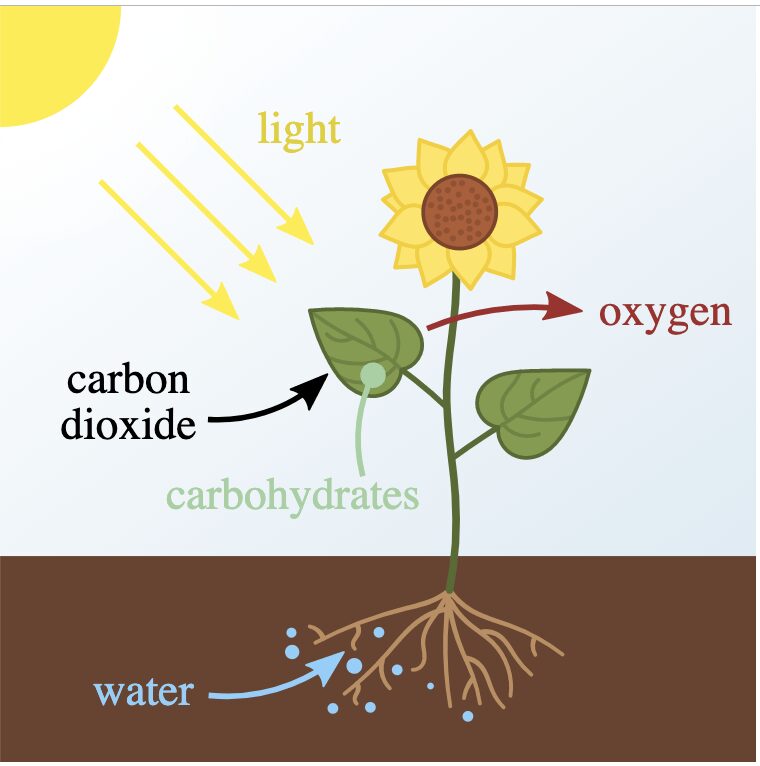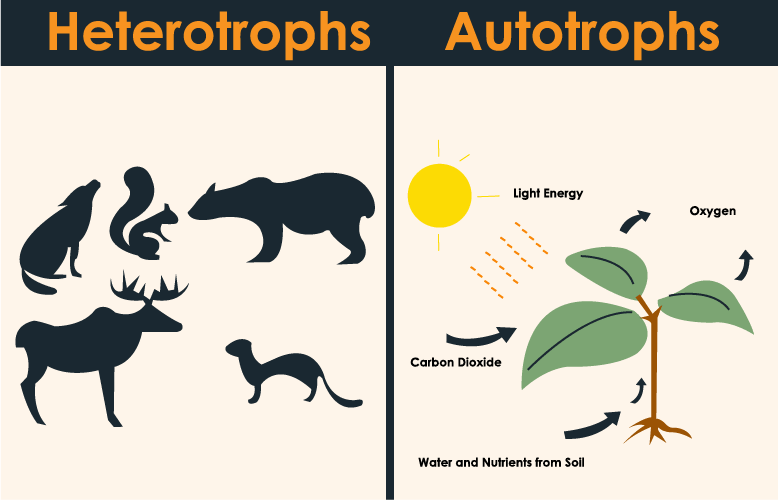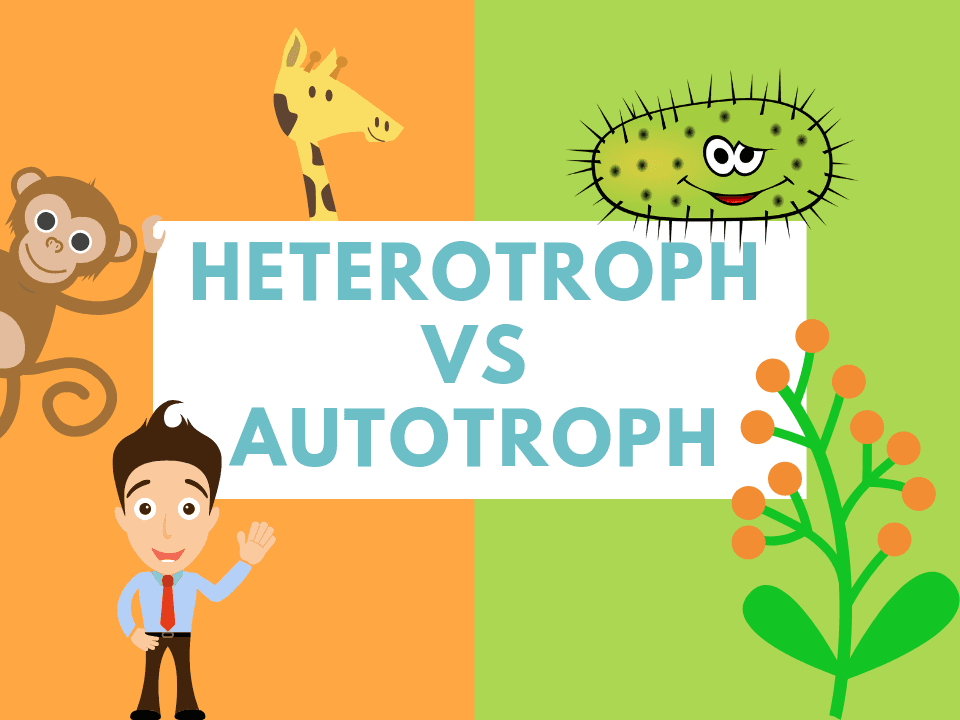In the world of biology, organisms are classified into different categories based on their ability to obtain energy and nutrients. Two main categories are autotrophs and heterotrophs. Autotrophs are organisms that can produce their own food using light (photosynthesis) or chemical energy (chemosynthesis) from substances available in their surroundings. On the other hand, heterotrophs cannot synthesize their own food and rely on other organisms, both plants and animals, for nutrition.
Understanding the difference between autotrophs and heterotrophs is crucial in comprehending the various mechanisms by which organisms obtain energy and nutrients. This article will explore the characteristics, examples, and energy production methods of autotrophs and heterotrophs, as well as their roles in the food chain.
What is Autotroph?
Autotrophs, also known as self-feeders or primary producers, are organisms that have the ability to produce their own food. They can convert substances available in their surroundings, such as carbon dioxide (CO2), into nutritional organic substances using either light or chemical energy.

Types of Autotrophs
There are two main types of autotrophs:
- Photoautotrophs: These autotrophs use energy from the sun to convert water from the soil and carbon dioxide from the air into glucose. Glucose provides energy to plants and is used to make cellulose, which forms the cell walls. Examples of photoautotrophs include plants, algae, phytoplankton, and some bacteria.
- Chemoautotrophs: Chemoautotrophs use energy from chemical reactions to produce food. These reactions typically involve substances like hydrogen sulfide or methane combined with oxygen. Chemoautotrophs obtain carbon dioxide as their main source of carbon. Bacteria found inside active volcanoes, hydrothermal vents in the sea floor, and hot water springs are examples of chemoautotrophs.
What is Heterotroph?
Heterotrophs are organisms that cannot produce their own food and depend on other organisms for nutrition. They obtain their energy by consuming organic matter produced by autotrophs or by feeding on other heterotrophs.

Types of Heterotrophs
There are two main types of heterotrophs:
- Photoheterotrophs: These heterotrophs use light for energy but cannot use carbon dioxide as their carbon source. Instead, they obtain their carbon from compounds such as carbohydrates, fatty acids, and alcohol. Examples of photoheterotrophs include purple non-sulfur bacteria, green-non sulfur bacteria, and heliobacteria.
- Chemoheterotrophs: Chemoheterotrophs obtain their energy by consuming preformed organic compounds through the oxidation process. They feed on other organisms, either dead or alive, to obtain energy. Animals, fungi, bacteria, and most pathogens are examples of chemoheterotrophs.
Difference Between Autotrophs and Heterotrophs
The main difference between autotrophs and heterotrophs lies in their ability to produce their own food. Autotrophs can synthesize organic compounds from inorganic substances like carbon dioxide, while heterotrophs rely on consuming other organisms in the food chain for their nutritional needs.
Here is a detailed comparison between autotrophs and heterotrophs:
| Characteristic | Autotrophs | Heterotrophs |
|---|---|---|
| Produce own food | Yes | No |
| Food chain level | Primary | Secondary and tertiary |
| Types | Photoautotroph, Chemoautotroph | Photoheterotroph, Chemoheterotroph |
| Examples | Plants, algae, some bacteria | Herbivores, omnivores, carnivores |
| Definition | Organism that can form nutritional organic substances from inorganic sources like carbon dioxide | Organism that cannot produce organic compounds from inorganic sources and relies on consuming other organisms in the food chain |
| How they obtain food | Produce their own food for energy | Obtain food by consuming other organisms |
Autotrophic & Heterotrophic Nutrition
Autotrophic and heterotrophic nutrition are the two main modes of nutrition in organisms.
Autotrophic Nutrition
Autotrophic nutrition involves the ability of organisms to synthesize their own food using energy from sunlight or chemical reactions. This mode of nutrition is primarily observed in autotrophs. The two main types of autotrophic nutrition are photosynthesis and chemosynthesis.
Photosynthesis
Photosynthesis is the process by which photoautotrophs convert light energy into chemical energy, which is stored in the form of glucose. This process occurs in the chloroplasts of plant cells and involves the absorption of sunlight, carbon dioxide, and water to produce glucose and oxygen.
Chemosynthesis
Chemosynthesis is the process by which chemoautotrophs use energy from chemical reactions to produce food. These reactions typically involve substances like hydrogen sulfide or methane combined with oxygen. Chemoautotrophs obtain carbon dioxide as their main source of carbon.
Heterotrophic Nutrition
Heterotrophic nutrition involves the consumption of preformed organic compounds as a source of energy and nutrients. This mode of nutrition is primarily observed in heterotrophs. The two main types of heterotrophic nutrition are saprophytic and holozoic nutrition.
Saprophytic Nutrition
Saprophytic nutrition is observed in organisms that obtain nutrients by decomposing dead organic matter. These organisms, known as saprophytes or decomposers, secrete enzymes that break down complex organic compounds into simpler forms, which they can then absorb and utilize for their own nutrition. Examples of saprophytes include fungi and bacteria.
Holozoic Nutrition
Holozoic nutrition involves the ingestion of solid food, which is then digested and absorbed. This mode of nutrition is observed in most animals, including herbivores, carnivores, and omnivores. The food is broken down into simpler forms through mechanical and chemical processes, such as chewing and enzymatic digestion, respectively.
Relationship between Autotrophs and Heterotrophs
Autotrophs and heterotrophs are interconnected through the food chain. Autotrophs, as primary producers, form the base of the food chain by converting energy from sunlight or chemical reactions into organic compounds. Heterotrophs, as consumers, rely on autotrophs for their energy and nutrient requirements.
The relationship between autotrophs and heterotrophs can be visualized in a food chain. Herbivores consume autotrophs, and carnivores consume other heterotrophs. This process continues, with each organism being a source of energy for the next trophic level.

Examples of Autotrophs
Autotrophs are found in various ecosystems and play a crucial role in sustaining life on Earth. Here are some examples of autotrophs:
- Plants: Trees, grasses, flowers, and all other green plants are examples of autotrophs that use photosynthesis to produce their own food.
- Algae: Algae are diverse photosynthetic organisms that can be found in aquatic environments. They are an essential part of the food chain, providing energy for other organisms.
- Phytoplankton: These microscopic autotrophs are found in oceans, lakes, and rivers. They are responsible for a significant portion of the Earth’s oxygen production.
- Cyanobacteria: Cyanobacteria, also known as blue-green algae, are photosynthetic bacteria found in various habitats, including freshwater and marine environments. They are capable of fixing atmospheric nitrogen, making them important contributors to nutrient cycles.
- Some Bacteria: Certain bacteria have the ability to perform photosynthesis or chemosynthesis, allowing them to produce their own food. Examples include purple sulfur bacteria and nitrifying bacteria.
Examples of Heterotrophs
Heterotrophs can be found in a wide range of organisms, including animals, fungi, and certain bacteria. Here are some examples of heterotrophs:
- Herbivores: Herbivores are animals that feed primarily on plants. Examples include cows, rabbits, and deer.
- Carnivores: Carnivores are animals that primarily consume meat. Examples include lions, wolves, and eagles.
- Omnivores: Omnivores consume both plants and animals. Humans, bears, and raccoons are examples of omnivorous animals.
- Fungi: Fungi are heterotrophic organisms that obtain nutrients by decomposing organic matter. Examples include mushrooms, molds, and yeasts.
- Some Bacteria: Certain bacteria are heterotrophs that obtain their energy by consuming organic matter. Examples include E. coli and Salmonella.
Energy Production
Autotrophs and heterotrophs have different mechanisms for energy production.
Autotrophs: Photosynthesis
Autotrophs, especially photoautotrophs, produce energy through photosynthesis. Photosynthesis is a process in which autotrophs use light energy to convert carbon dioxide and water into glucose and oxygen. The glucose produced during photosynthesis serves as a source of energy for the autotroph and is used to build other organic compounds.
Heterotrophs: Cellular Respiration
Heterotrophs obtain energy by breaking down organic molecules through a process called cellular respiration. Cellular respiration involves the conversion of glucose and other organic compounds into carbon dioxide, water, and energy in the form of ATP (adenosine triphosphate). This energy is then used by heterotrophs for various metabolic activities.
Food Chain
The relationship between autotrophs and heterotrophs is further illustrated in the food chain. Autotrophs, as primary producers, form the base of the food chain by converting energy from sunlight or chemical reactions into organic compounds. Heterotrophs, as consumers, feed on autotrophs or other heterotrophs to obtain energy and nutrients.
In a typical food chain, herbivores consume autotrophs, carnivores consume herbivores, and so on. This transfer of energy and nutrients continues through each trophic level of the food chain. Decomposers, such as fungi and bacteria, play a vital role in breaking down dead organic matter, returning nutrients to the environment for autotrophs to utilize.

Photosynthesis
Photosynthesis is a vital process for autotrophs, allowing them to convert light energy into chemical energy. It involves the absorption of sunlight, carbon dioxide, and water to produce glucose and oxygen. The process takes place in the chloroplasts of plant cells, specifically in the thylakoid membranes and the stroma.
During photosynthesis, light energy is captured by pigments like chlorophyll, which are located in the chloroplasts. This energy is then used to split water molecules into oxygen and hydrogen ions. The hydrogen ions, along with electrons from water, are used to convert carbon dioxide into glucose, a process known as the Calvin cycle.
Photosynthesis plays a crucial role in the carbon cycle and the production of oxygen. It is the primary source of energy for most ecosystems, as it provides the foundation for the food chain.
Cellular Respiration
While autotrophs generate energy through photosynthesis, heterotrophs rely on cellular respiration to produce ATP, the energy currency of cells. Cellular respiration involves the breakdown of glucose and other organic compounds to release energy in the form of ATP.
Cellular respiration occurs in three main stages: glycolysis, the Krebs cycle, and the electron transport chain. During glycolysis, glucose is broken down into two molecules of pyruvate, generating a small amount of ATP. The Krebs cycle further breaks down pyruvate, producing carbon dioxide, ATP, and electron carriers.
The electron transport chain is the final stage of cellular respiration, where electrons from electron carriers are transferred through a series of protein complexes. This transfer of electrons generates a large amount of ATP. The overall process of cellular respiration is highly efficient, allowing heterotrophs to extract the maximum amount of energy from organic compounds.
Examples on Difference Between Autotrophs and Heterotrophs
To better understand the concept of autotrophs and heterotrophs, let’s take a look at some examples that highlight their differences.
Example 1: Plants vs. Animals
Plants are examples of autotrophs because they can produce their own food through photosynthesis. They convert sunlight, water, and carbon dioxide into glucose and oxygen. In contrast, animals are examples of heterotrophs because they rely on consuming other organisms, including plants, for their energy and nutrient needs.
Example 2: Algae vs. Fish
Algae, such as phytoplankton, are autotrophs that obtain energy through photosynthesis. They serve as a primary food source for various aquatic organisms. Fish, on the other hand, are heterotrophs that consume other organisms, including algae, for their energy.
Example 3: Bacteria vs. Fungi
Some bacteria, like cyanobacteria, can perform photosynthesis and are therefore autotrophs. They derive energy from sunlight and carbon dioxide. In contrast, fungi are heterotrophs that obtain nutrients by decomposing organic matter. They play a crucial role in the recycling of nutrients in ecosystems.
How Kunduz Can Help You Learn Difference Between Autotrophs and Heterotrophs?
Kunduz is a trusted educational platform that can help you learn and understand the difference between autotrophs and heterotrophs. Kunduz provides comprehensive resources to enhance your knowledge in biology and other subjects.
By accessing Kunduz, you can access detailed explanations, step-by-step solutions. Whether you’re preparing for exams or seeking a deeper understanding of biology concepts, Kunduz is your reliable companion on your academic journey.
